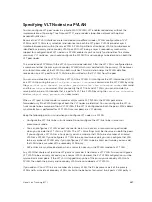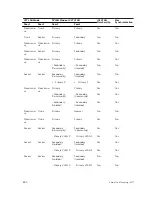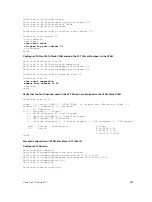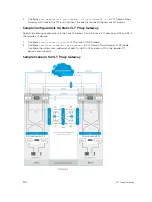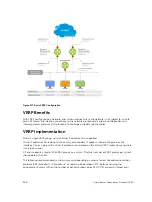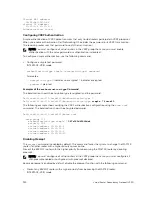
54
VLT Proxy Gateway
The Virtual link trucking (VLT) proxy gateway feature allows a VLT domain to locally terminate and route
L3 packets that are destined to a L3 end point in another VLT domain. Enable the VLT proxy gateway
using the link layer discover protocol (LLDP) method or the static configuration. For more information,
refer to
Dell Networking OS Command Line Reference Guide
.
Proxy Gateway in VLT Domains
Using a proxy gateway, the VLT peers in a domain can route the L3 packets destined for VLT peers in
another domain as long as they have L3 reachability for the IP destinations.
A proxy gateway in a VLT domain provides the following benefits:
• Avoids sub-optimal routing of packets by a VLT domain when packets are destined to the endpoint in
another VLT domain.
• Provides resiliency if a VLT peer goes down by performing proxy routing for the peer’s destination
MAC address in another VLT domain.
A typical scenario is virtual movement of servers across data centers. Virtual movement enables live
migration of running Virtual Machines (VMs) from one host to another without a downtime. Consider a
square VLT connecting two data centers. If a VM, say VM1 on Server Rack 1 has C as its default gateway
and VM1 performs a virtual movement to Server Rack 2 with no change in default gateway, then L3
packets destined for C can be routed either by C1 or D1 locally. This behavior is achieved by installing the
local system mac address of C and D in both C1 and D1 so the packets for C and D could have a hit at
C1 /D1 and be routed locally.
In the following figure, server racks, named Rack 1 and Rack 2, are part of data centers, named DC1 and
DC2, respectively. Rack 1 is connected to devices A and B in Layer 2. Similarly, Rack 2 is connected to
devices A and B in Layer 2. A VLT Link Aggregation Group (LAG) is present between A and B. A and B are
connected to core routers, C and D. VLT routing is present between C and D.
Similarly, C1 and D1 are Layer 3 core routers in DC2, in which VLT routing is enabled. The core routers C
and D in the local VLT domain is connected to the core routers C1 and D1 in the remote VLT Domain
using VLT links in eVLT fashion. The core or Layer 3 routers C and D in local VLT Domain and C1 and D1
in the remote VLT Domain are then part of a Layer 3 cloud.
900
VLT Proxy Gateway
Summary of Contents for Z9000
Page 1: ...Dell Configuration Guide for the Z9000 System 9 7 0 0 ...
Page 80: ...grub reboot 80 Management ...
Page 128: ... 0 Te 1 1 Te 1 2 rx Flow N A N A 128 Access Control Lists ACLs ...
Page 491: ...Figure 70 Configuring OSPF and BGP for MSDP Multicast Source Discovery Protocol MSDP 491 ...
Page 496: ...Figure 73 MSDP Default Peer Scenario 1 496 Multicast Source Discovery Protocol MSDP ...
Page 497: ...Figure 74 MSDP Default Peer Scenario 2 Multicast Source Discovery Protocol MSDP 497 ...
Page 498: ...Figure 75 MSDP Default Peer Scenario 3 498 Multicast Source Discovery Protocol MSDP ...
Page 760: ...Figure 100 Single and Double Tag TPID Match 760 Service Provider Bridging ...
Page 761: ...Figure 101 Single and Double Tag First byte TPID Match Service Provider Bridging 761 ...


